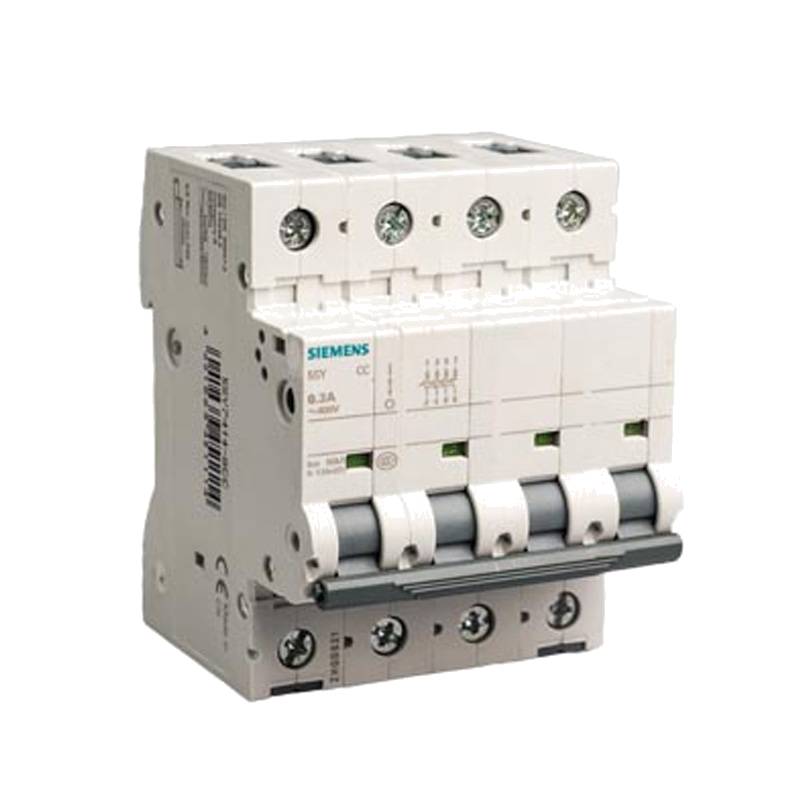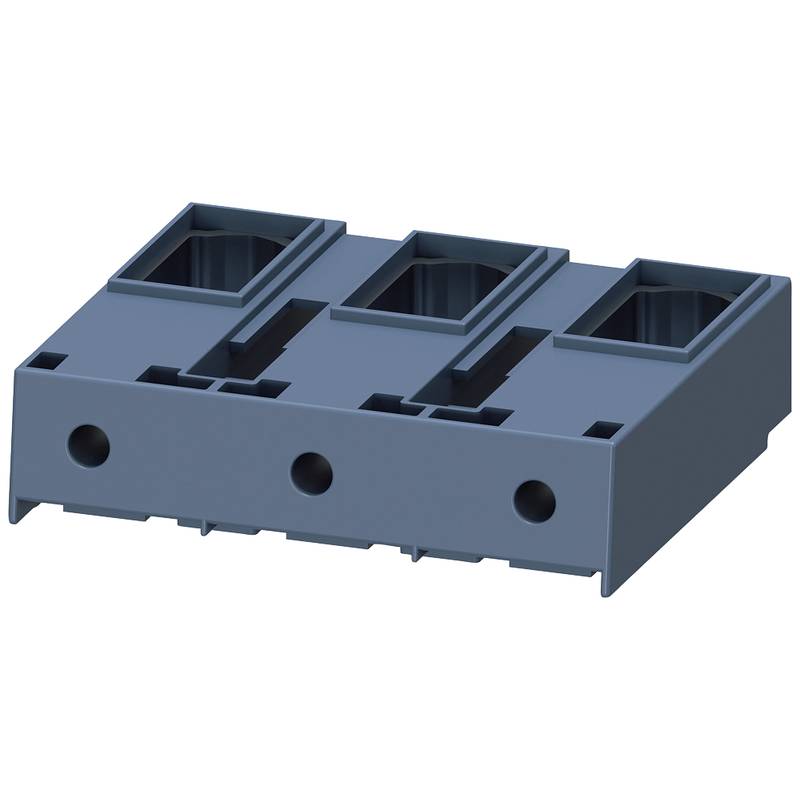
The Siemens 5SY6663-8CC Industrial Single Phase Motor Protection Breaker is a robust 3-pole + Neutral (3P+N) device rated for 63A, designed for reliable protection of electrical circuits and motors in demanding industrial environments. This miniature circuit breaker (MCB) offers a breaking capacity of 6kA at 400V AC, ensuring safety and operational continuity. Key advantages include its compact design, high breaking capacity, and suitability for motor protection applications. The 5SY6663-8CC features a tripping characteristic that provides essential overload and short-circuit protection, crucial for preventing damage to sensitive equipment and ensuring personnel safety.
Product Specifications
| Specification | Value |
| :--------------------------- | :------------------------ |
| Product Type | Miniature Circuit Breaker |
| Model Number | 5SY6663-8CC |
| Rated Current (In) | 63 A |
| Number of Poles | 3P+N |
| Rated Voltage (Ue) | 400 V AC |
| Breaking Capacity (Icn) | 6 kA |
| Tripping Characteristic | Not specified (e.g., B, C, D) |
| Frequency | 50 Hz |
| Protection Class | IP20 (with connected conductors) |
| Mounting Depth | 70 mm |
| Energy Limiting Class | 3 |
| Degree of Pollution | 3 |
| Type of Voltage | AC/DC |
Core Features & Market Positioning
The Siemens 5SY6663-8CC stands out due to its specific configuration as a 3P+N breaker, offering comprehensive protection for circuits where a neutral conductor is critical, such as in certain motor control systems. Its 6kA breaking capacity aligns with general industrial standards, providing adequate protection against common fault currents. The Siemens brand itself carries significant weight in the industrial sector, positioning this breaker as a reliable choice backed by a global leader in electrical engineering. While specific competitive differentiators are not extensively detailed in product listings, its solid construction and adherence to Siemens' quality standards are implied benefits. The availability of similar models, such as the 5SY6663-7 with a Type C characteristic, suggests a range of protection options within the 5SY series tailored to different load types.
Key Application Scenarios
This Siemens 5SY6663-8CC industrial breaker is ideally suited for protecting single-phase and three-phase circuits, particularly those involving motors, in commercial and industrial settings. Its 3P+N configuration makes it effective for applications requiring neutral conductor protection, common in machinery, pumps, and HVAC systems where unbalanced loads or specific motor starting characteristics are present. Industrial facilities, manufacturing plants, and control panels are primary deployment areas where robust overcurrent and short-circuit protection is paramount. The 63A rating is suitable for medium-sized industrial loads.
Practical System Integration Guidance
Integrating the Siemens 5SY6663-8CC into an existing electrical system is straightforward, typical for miniature circuit breakers. Installation involves mounting the unit onto a standard DIN rail within a distribution board or control panel. Proper wiring connections are essential, ensuring the phase conductors and the neutral conductor are correctly terminated according to local electrical codes and the breaker's specifications. While specific programming is not applicable to this electromechanical device, understanding its tripping characteristics (e.g., B, C, or D curve, though not specified for the -8CC variant) is crucial for ensuring correct selectivity and coordination with other protective devices in the system to prevent nuisance tripping and ensure effective fault clearance.
Operation and Risk Mitigation
The Siemens 5SY6663-8CC operates automatically, interrupting the circuit when fault currents exceed its rated breaking capacity or when overloads persist. Users can manually operate the breaker via the toggle switch. Risk mitigation is achieved through its primary function of preventing electrical fires and equipment damage caused by overcurrents and short circuits. It is imperative to ensure the breaker's rated current and breaking capacity are appropriately matched to the circuit being protected. Incorrect installation or application can lead to premature failure or a failure to trip, compromising safety. Regular visual inspections for damage and proper system grounding are fundamental safety practices.
Scalability & Long-Term Value
While the Siemens 5SY6663-8CC is a standalone protective device, its long-term value lies in its robust construction and the reliability associated with the Siemens brand, suggesting a long operational lifespan. Scalability in this context refers more to system design rather than the breaker itself. It can be integrated into larger Siemens industrial control and distribution systems, allowing for modular expansion of protection as facility needs grow. Compatibility with other Siemens SENTRON components, such as residual current devices or surge protection, further enhances its value by enabling comprehensive electrical protection schemes. Integration with IIoT solutions would typically occur at a higher system level, with data from the distribution network being monitored, rather than directly from the breaker itself.
Frequently Asked Questions (FAQs)
What is the primary function of the Siemens 5SY6663-8CC breaker?
The Siemens 5SY6663-8CC serves as a crucial safety device for motor protection. It is designed to detect and interrupt overcurrents and short circuits, preventing damage to electrical equipment and mitigating fire hazards.
This breaker's core purpose is to ensure operational safety and reliability in industrial electrical systems by providing essential overload and short-circuit protection. It safeguards connected machinery and wiring from electrical faults that could lead to significant damage or downtime.
Its specific 3P+N configuration indicates its suitability for circuits requiring neutral conductor integrity, often found in motor control applications or systems with unbalanced loads.
What are the key technical specifications of the Siemens 5SY6663-8CC?
This industrial breaker is rated for 63 Amperes (A) and features a 3-pole plus neutral (3P+N) configuration. It operates at a voltage of 400 Volts (V) AC and possesses a breaking capacity of 6 kiloamperes (kA).
The breaker is designed for a 50 Hz supply frequency and has an energy-limiting class of 3, indicating its effectiveness in restricting fault energy. Its mounting depth is typically 70 mm, fitting standard industrial enclosures.
The device is rated for AC/DC voltage types and has a pollution degree of 3, suitable for many industrial environments. The IP20 protection class applies when conductors are connected.
Where is the Siemens 5SY6663-8CC breaker typically used?
The Siemens 5SY6663-8CC is ideal for protecting single and three-phase circuits, particularly those powering industrial motors. Its 3P+N design is beneficial for applications where neutral protection is critical, such as in pumps, fans, or machinery.
It is commonly installed in industrial distribution boards, control panels, and electrical cabinets within manufacturing plants, workshops, and commercial facilities. The 63A rating suits medium-sized industrial loads requiring robust protection.
This breaker ensures the safety and longevity of equipment by preventing damage from electrical faults, thereby minimizing unscheduled downtime and maintenance costs in these demanding environments.
What does the '3P+N' designation mean for this Siemens breaker?
The '3P+N' designation signifies that the breaker has three poles for phase conductors and an additional pole for the neutral conductor. This provides integrated protection for both the phases and the neutral line in a single device.
This configuration is particularly important for circuits supplying equipment like motors, which may require a neutral connection or can experience unbalanced loads. It ensures that fault conditions on any of the three phases or the neutral line trigger the protective action.
Having a dedicated neutral pole offers enhanced safety and operational integrity compared to a 3-pole breaker where the neutral might be switched separately or not protected at all, making it suitable for specific industrial electrical distributions.
How does the 6kA breaking capacity of the 5SY6663-8CC protect a system?
A breaking capacity of 6 kA means the breaker can safely interrupt fault currents up to 6,000 Amperes without sustaining damage. This is a critical safety feature that prevents catastrophic failures during a short circuit.
When a short circuit occurs, very high currents can flow. The breaker's ability to rapidly quench the arc and interrupt this massive current protects the surrounding electrical infrastructure, preventing fires and equipment destruction.
This rating is suitable for many common industrial applications where the potential fault current is within this limit, ensuring reliable protection in typical installation scenarios.
Can the Siemens 5SY6663-8CC be used for residential applications?
While technically capable of providing protection, the Siemens 5SY6663-8CC is specifically designed and marketed for industrial applications. Its 3P+N configuration and 63A rating are more typical for industrial loads and motor protection.
Residential electrical panels typically use single-pole, double-pole, or sometimes 3-pole breakers with lower ampere ratings and different configurations tailored to household circuits. Using an industrial breaker in a residential setting may not comply with local electrical codes.
For residential use, it is always recommended to select circuit breakers that are specifically designed and approved for home electrical systems, ensuring proper safety and compliance with building regulations.
What is the tripping characteristic of the Siemens 5SY6663-8CC?
The exact tripping characteristic (e.g., Type B, C, or D) for the Siemens 5SY6663-8CC is not explicitly stated in the primary product details found. However, the '-8CC' in the model number might suggest a specific characteristic, though this requires further confirmation from Siemens documentation.
Tripping characteristics define how quickly a breaker responds to overcurrents, with different types suited for various load sensitivities. Type B is for low inrush currents, Type C for moderate inrush (like motors), and Type D for high inrush.
It is essential to consult the detailed product datasheet or contact Siemens for precise information on the tripping curve to ensure correct application and system selectivity.
What is the difference between the 5SY6663-8CC and other 5SY6663 models like the -7?
The primary difference often lies in the tripping characteristic, denoted by the letter following the dash (e.g., '-7' might indicate Type C, as seen in some listings). The '-8CC' may imply a specific characteristic, potentially a Type C or similar variant optimized for motor protection.
Models like the 5SY6663-7 are confirmed to have a Type C tripping characteristic, suitable for loads with moderate inrush currents such as small motors. The '-8CC' variant is likely tailored for similar or specific industrial motor protection needs.
Always verify the specific tripping curve (B, C, D, etc.) for any given model number to ensure it aligns with the application's load requirements and desired protection selectivity.
How is the Siemens 5SY6663-8CC installed?
Installation involves snapping the breaker onto a standard 35mm DIN rail within an electrical enclosure, such as a distribution board or control panel. Ensure the correct orientation and secure mounting.
Wiring connections must be made meticulously. The line (input) terminals should be connected to the power source, and the load (output) terminals to the circuit being protected. The neutral conductor must be connected to its designated pole.
Always follow local electrical codes and safety guidelines during installation. Ensure the power is disconnected before commencing any work to prevent electrical shock.
What are the typical maintenance requirements for this breaker?
For most miniature circuit breakers like the Siemens 5SY6663-8CC, regular physical inspection is the primary maintenance. Check for any signs of physical damage, overheating (discoloration), or corrosion on the terminals.
While not requiring periodic calibration, it's advisable to periodically test the breaker's function, especially in critical applications. This can involve manually operating the switch to ensure smooth action and, if possible, using specialized testing equipment to verify trip performance.
Ensure the surrounding area in the electrical panel is kept clean and free from dust or debris, which can affect cooling and potentially lead to premature failure. Adhering to operating and environmental specifications also contributes to longevity.























